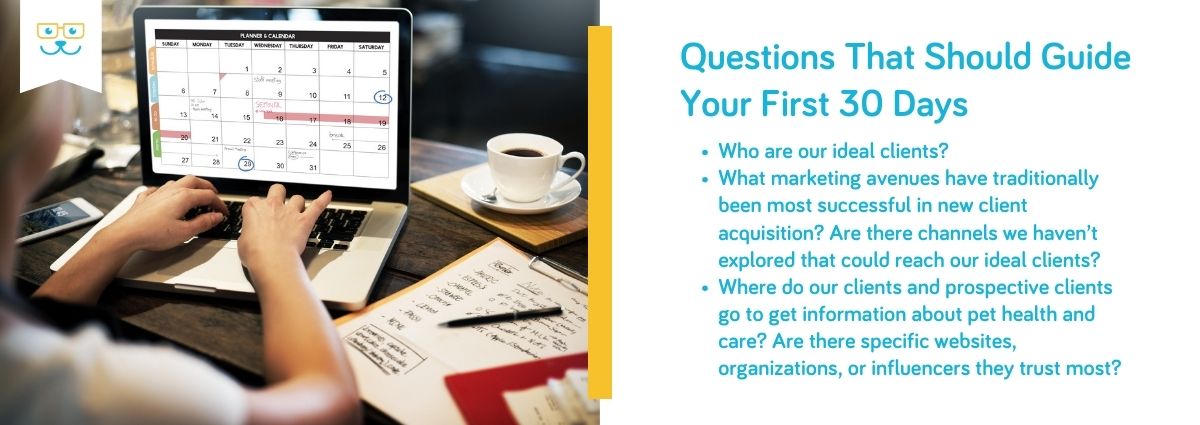How to Build the Ultimate 30-60-90 Day Plans for Veterinary Marketing Leaders
In the competitive field of veterinary care, effective marketing is essential for success. A 30-60-90 day plan serves as a detailed roadmap for marketing leaders, guiding them through the crucial first three months in a new role. This plan is not just a document; it's a blueprint for achieving tangible results and long-term growth.
In this blog, we'll walk you through what a 30-60-90 day plan is, why your marketing manager should have one, and what your plan needs to include to set your team – and your practice – up for success.
What Is a 30-60-90 Day Plan?
A 30-60-90 day plan is a structured roadmap outlining goals, strategies, and tactics to be accomplished within specific timeframes: the first 30 days, the following 30 days (days 31-60), and the subsequent 30 days (days 61-90). These strategic plans are often an integral part of a new marketing manager or director’s onboarding, and can serve as a guiding light to help get marketing initiatives up to speed during this transition period and ensure that the marketing team is working toward a set group of long and short-term goals. In short, a 30-6-90 day plan serves as a blueprint for guiding your marketing efforts and achieving desired outcomes within a defined timeline.
30-60-90 day plans aren’t just limited to marketing either! These plans can be adapted for any role on your team and help set goals and progress expectations for new hires or existing staff who might need a nudge in the right direction. While these plans are versatile and can be used for anyone from front office staff to executive management, we’ll be focusing on plans for marketing managers and directors in this blog.
Why Should You Have a 30-60-90 Day Plan?
In the fast-paced world of veterinary care, every minute counts – and this is especially true for those taking on marketing responsibilities. Marketing initiatives like email campaigns, social media marketing, and paid advertising can’t be put on hold for a few weeks while a marketing manager works through onboarding or systems training.
Now, you might wonder: why the emphasis on the 30-60-90 day timeframe? The answer lies in the urgency of the veterinary industry, where every day presents new opportunities to connect with clients, drive engagement, and foster brand loyalty. Developing a 30-60-90 day plan allows your marketing manager to hit the ground running and get started right away, without leaving current campaigns or initiatives hanging in limbo. By appropriately tracking and highlighting role milestones, these plans can also help both your marketing manager and stakeholders feel more confident that real progress is being made.
How to Build a 30-60-90 Day Plan for Veterinary Marketers
1. Do Your Due Diligence
Whether you’re creating a 30-60-90 day plan for yourself or creating one for a staff member, before you start dreaming up what metrics you’re going to improve and what lofty goals you’re going to set, the first thing you should always do is due diligence.
The first few days after you or a new hire have taken over marketing should primarily consist of learning and research. But we aren’t talking about the typical learning we associate with other veterinary roles like taking blood or conducting a wellness exam. Instead, this research and learning will primarily focus on understanding your target audience, determining what has and hasn’t worked in the past, and learning how the practice’s mission and values will shape your marketing strategies.
This background research and due diligence will help ensure that every decision you make and goal you set is backed by evidence and data and will ultimately contribute to the growth and success of the practice.


2. Outline Your Phases and Timelines and Set Appropriate Goals
Once you’ve done your research and have a solid understanding of your target clients and how they’ve responded to past initiatives, you’ll move on to the next phase of creating a successful 30-60-90 day plan: determine what you want to achieve and when you want to achieve it. This will help define primary goals or themes for each of the three stages of the 30-60-90 day plan.
When working on goal setting it’s important to strike a balance between what will most benefit the practice and what can realistically be achieved in a given time period. For example, for a practice looking to increase the number of patients on their schedule each day, setting a goal of increasing client email open rates by 30% in your plan is neither realistic nor helpful for your practice’s goal. Instead, think about how you can make the biggest impact within your first 90 days and build your goals from there. This could result in creating goals like generating 20 new client leads by day 60 or increasing conversion rates on an appointment setting form by 15%.
Remember, you don’t need to move mountains within the scope of a 30-60-90 plan and falling short of some goals doesn’t necessarily mean failure. A 30-60-90 plan in the context of marketing is meant to be a helpful tool that encourages focus and progress, not stress.
3. Identify Key Strategies and Tactics
Based on your goals and timelines, you can then move on to identifying the strategies and tactics you'll employ to achieve them. This could include content marketing, social media engagement, email campaigns, search engine optimization (SEO), and community outreach among others. While there are numerous online templates and premade 30-60-90 day plans available online, remember this: Your 30-60-90 day plan will be as unique as your practice, and what works for one clinic may not be the best approach to achieve your clinic’s goals.
4. Allocate the Necessary Resources and Set Your Budget
At the outset of your veterinary marketing plan, it's crucial to prioritize the less exciting but essential tasks of resource allocation and budget setting. The first step is to conduct a thorough assessment of the resources needed to execute your strategies effectively. This encompasses manpower, tools, and technology required for implementing your marketing initiatives. It's important to evaluate whether your internal team has the expertise to handle tasks like content creation, social media management, and search engine optimization, or if you should consider outsourcing to specialized agencies or freelancers.
Once you've identified your resource needs, the next step is to set a realistic budget that aligns with your goals and objectives. This is a pivotal stage that determines the success of your veterinary marketing plan. By deciding on the amount you're willing to invest in marketing efforts and distributing funds across various channels and tactics, you're laying the groundwork for success. Remember, a well-planned budget not only maximizes your ROI but also fosters confidence in the effectiveness of your marketing efforts. Regularly monitor your spending and adjust your budget as needed based on the performance of your marketing campaigns. By allocating resources wisely and setting a realistic budget, you can ensure that your veterinary marketing plan is executed efficiently and effectively.
5. Get Going!
If the first 30 days of a plan for a new role are about listening and learning, then the next 60 are all about action. Effective marketing in the veterinary industry demands agility and responsiveness to the ever-changing landscape. Armed with insights gained from the initial phase, it's time to implement your strategies with confidence and vigor.
Execute your plan with precision and enthusiasm. Whether it's launching targeted social media campaigns, optimizing your website for search engines, or organizing community events, every action you take should be purposeful. This ensures that each effort contributes to your overarching goals, keeping you focused and on track.
Flexibility is key as you progress through the second phase of your plan. Stay adaptable and open to adjustments. Monitor the performance of your marketing activities closely and be prepared to pivot if certain strategies aren't yielding the desired results. Remember, agility is key to staying ahead of the competition and capturing the attention of your target audience.
By maintaining momentum and embracing a proactive approach to marketing, you'll not just position your veterinary practice for success in the months ahead, but you'll also pave the way for a thriving future. So, roll up your sleeves and get ready to make a lasting impact with your marketing efforts!

How to Measure the Success of Your Plan
So you've built the perfect 30-60-90 day plan to ramp up your marketing initiatives and make some marketing magic happen; now what? Assessing how well your plan is working and contributing to your practice’s growth and revenue goals is crucial to getting the most out of your early marketing efforts.
Here are a few key points to keep top of mind when assessing the success of your plan or when looking for new avenues to improve and optimize your marketing initiatives:
- Key Performance Indicators (KPIs): Identify specific KPIs aligned with your goals, such as website traffic, lead generation, appointment bookings, and client retention rates. Regularly track these metrics to gauge the impact of your marketing efforts.
- ROI Analysis: Calculate the return on investment (ROI) for each marketing initiative by comparing the costs incurred with the revenue generated or the value of acquired leads. This allows you to assess the profitability and efficiency of your campaigns.
- Conversion Rate Optimization (CRO): Analyze conversion rates at various stages of the customer journey, from initial engagement to conversion and retention. Identify bottlenecks and areas for improvement to optimize your conversion funnels and enhance overall performance.
- Client Feedback and Satisfaction: Solicit feedback from clients through surveys, reviews, and testimonials to gauge their satisfaction with your services and marketing efforts. Use this input to address any issues and enhance the customer experience.
- Competitive Benchmarking: Monitor the marketing strategies and performance of your competitors to benchmark your progress and identify areas where you can gain a competitive edge.
Need help ramping up your marketing initiatives? Schedule a demo today to learn how GeniusVets can help transform your veterinary marketing efforts.

